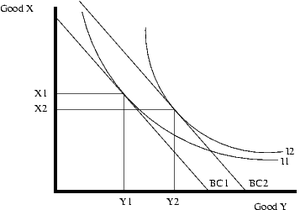This article needs additional citations for verification. (October 2009) |

In economics, inferior goods are those goods the demand for which falls with increase in income of the consumer. So, there is an inverse relationship between income of the consumer and the demand for inferior goods.[1] There are many examples of inferior goods, including cheap cars, public transit options, payday lending, and inexpensive food. The shift in consumer demand for an inferior good can be explained by two natural economic phenomena: the substitution effect and the income effect.
- ^ Sethi, D.K. ISC Economics (18th ed.). p. 11. ISBN 9789386811684.